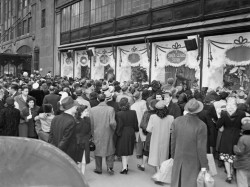Blog Archives
It began with Wolf and Dessauer. In the years before shopping malls and chain retail stores, Wolf and Dessauer was where Fort Wayne shopped. A purely local department store, it made its name as a place that was not just for shopping, but twas a social experience, with high levels of customer service, lounging rooms for tired shoppers, and access to telephones for people who who did not yet have one at home.
And Christmas was (so I hear; it was before my time) a magical time at W&D. They were famous for their magic windows, which some say were the equal of Macy’s.
In 1937 W&D hung a 25 foot wreath containing a reported 40,000 lights from the side of the building. Then in 1940 they constructed a 51 yard long display of Santa and his reindeer . Made of wood and containing (depending on which of the many unverified sources one believes) between 24,000 and 40,000 lights. It took workers several weeks to hang it, using blocks and tackles to haul the pieces manually up the side of the building.
 The display was only up for two years before WWII intervened, with demands for reductions in energy usage and night-time blackout requirements. (Fort Wayne was, and is, an important industrial city, and apparently officials were worried the Germans might sneak across the Atlantic and 700 miles of U.S. territory without being detected to bomb armament factories.) Shut down for three years, the display returned in 1945, a joyous symbol of the end of war.
The display was only up for two years before WWII intervened, with demands for reductions in energy usage and night-time blackout requirements. (Fort Wayne was, and is, an important industrial city, and apparently officials were worried the Germans might sneak across the Atlantic and 700 miles of U.S. territory without being detected to bomb armament factories.) Shut down for three years, the display returned in 1945, a joyous symbol of the end of war.
Santa and the wreath were displayed for 14 years, then put into storage when Wolf and Dessauer moved to a new building, and was not put up again the next Christmas.
 In 1962 the old building was destroyed in one of the largest fires in Fort Wayne history. As firefighters struggled against large crowds and freezing weather that froze the spray from their firehoses, five buildings were damaged or destroyed, and at least one fireman lost his life.
In 1962 the old building was destroyed in one of the largest fires in Fort Wayne history. As firefighters struggled against large crowds and freezing weather that froze the spray from their firehoses, five buildings were damaged or destroyed, and at least one fireman lost his life.
In 1966 Wolf and Dessauer sold their business to City Stores, a Delaware-based retail store holding company, and in 1969 City Stores sold W&D to Indianapolis-based department store chain L.S. Ayres. (See the subsequent history of Ayres below.*) L.S. Ayres had a store at the newly opened Glenbrook mall, then on the edge of the city, and in the early 1970s closed the downtown store.
My mother says she used to take my siblings and me to W&D to see the magic windows and sit on Santa’s lap every year before the store closed. Unfortunately I have only the very faintest memories of that, wholly without detail, and perhaps they’re really only memories of being told that we did that. And while my oldest brother and sister might have seen the Santa display as infants, it was already several years gone before I was born. But for older people, the Wolf and Dessauer Santa and wreath were among their most nostalgic memories.
For 20 years, longer than the original Santa had flown across the W&D store, and only a few years less than the wreath had hung there, the displays were lost. Or perhaps their location was known all along, but nobody was interested in reviving them. Or more likely, perhaps, the owners of W&D decided not to redisplay them after the move, and then as the company was sold and re-sold and old-timers of the company left the knowledge of the displays’ location was not passed on, and the new owners, managers actually, no longer locals but corporate types in distant cities, knew nothing of them and might not have cared if they did. They were running regional and national firms, not a local one.
Whatever the real story, in the spring of 1979 the displays were serendipitously discovered in a warehouse. That Christmas, two restored reindeer were displayed on the side of a downtown parking garage. In 1980, the whole display was lit for the first time since 1959, and has been displayed every year since. 2015 makes the 36th year of continuous display in its second incarnation, twice as long as its original display, and closing in on as many years as it was first displayed and then lost combined.
Today the historic Embassy Theater–a grand movie palace from the 1920s, now operated by a non-profit foundation–creates magic windows. Probably never again can we recapture the experience of a Wolf and Dessauer Christmas, but it’s still a wondrous experience to take my kids to see them. It’s a part of Fort Wayne that is special–beautiful, dazzling, historical, and evocative of the connections between past and present, all the more precious because they were once lost.

And today many of us have a bit of this history decorating our own homes at Christmas. In the mid 2,000s the tens of thousands of 11 watt bulbs were replaced with LEDs to save in energy costs (although three times the cost of the older bulbs, the LEDs were expected to pay for themselves in just two years). The old bulbs were given to charities to sell as Christmas ornaments. My Christmas gift from my mom that year was one of the old bulbs. It has hung on my Christmas tree every year since, and while my kids do the majority of the tree decorating (one of our annual gifts to them is an ornament each, and it’s great to watch them remember and reconnect with them each year), the bulb is one of the few ornaments I personally hang.
_____________________________
*Ayres was purchased by Associated Dry Goods of New York City in 1972, which then merged Ayres with the Cincinnati-based Pogues, keeping the Ayres name. In 1986 the May Department Store Company acquired Associated Dry Goods, and in 1987 Associated Dry Goods was renamed L.S. Ayres and Company. Ayres was then merged with St. Louis-based Famous-Barr (also owned by May) in 1991. In 2005, Federated Department Stores, which had previously purchased Macy’s, purchased the May company and merged Ayres into its Macy’s division, apparently ending the Ayres retail name.
Applesauce cookies!
These were a staple of my childhood, and are now a staple of my children’s childhood. My mom discovered the recipe years ago when she wanted to bake but didn’t have any eggs nor money to buy any. These are the only sweet against which I have no willpower. Making them today with my daughter, we both had to restrain ourselves against eating up all the dough before we made any actual cookies.
The cinnamon and cloves make this an ideal fall treat, but they’re great any time of year.
Ingredients
– 1 cup shortening
– 2 cups sugar
– 2 cups unsweetened applesauce
– 4 cups flour
– 2 teaspoons baking soda
– 1 teaspoon salt
– 2 teaspoons cinnamon
– 1 teaspoon cloves
Directions
* Preheat oven to 375
* Cream sugar and shortening together
* Blend in applesauce
* Blend baking soda, salt, cinnamon and cloves into the flour
* Blend the dry mix into the creamed, adding about 1/3 at a time
* Grease cookie sheet (the cookies will stick otherwise)
* Use dinner spoons to drop balls of dough onto the sheet – do not make them too big
* Cook for 12 minutes
Two notes of warning
- The recipe is notoriously finicky. Small differences in the amount of ingredients, especially the baking soda and flour, can really affect the taste and texture, respectively. Sunspots and the color of shirt you’re wearing may also affect them. If they don’t taste wonderful, don’t despair, just try again. Once in a while I still have a batch that’s not quite right.
- I use homemade applesauce because the cookies need the rougher texture. Maybe you can find a more naturally textured applesauce in the store, but with the standard smooth applesauce the cookies will lay down flat like little pancakes. The homemade applesauce is easy — just simmer about 6 apples in a cup of water until soft (about ½ hour), then mash them up. I use a potato masher. Just don’t blend until smooth. I use a combination of apples, a couple Golden Delicious for tartness and Fuji, Gala or Macintosh for their flavor and I don’t add any seasoning to the mash.
Some years back I met a guy who eagerly billed himself as “the angriest mayor in America.” He was coming to speak to some of our students. He eagerly told me that he hated economists, except this one economist, a guy who unlike all the other economists told it like it really is. He then proceeded to spin some bullshit that, of course, nearly every economist rejects. But he’d found that one guy with an Econ PhD who confirmed his economic beliefs, and that was the evidence he needed to support his claim that he was right and almost all economists were wrong.
Bryan Caplan would surely shake his head in amused or weary acknowledgement of the mayor’s foolishness. And yet Caplan has done the same, in choosing Thomas Szasz as his go-to psychologist. Szasz argued that the mental illness/disease model was wrong, and that “there is no such thing as ‘mental illness’” (source). Although rejected (at least in his more extreme pronouncements) by the majority of the psych profession,* Szasz confirms for Caplan what Caplan wants to be true about psychology. That is, Caplan wants to treat these issues as merely one of preferences. (more…)
Hillary Clinton, never one to miss an opportunity to pander, told a prospective Iowa voter that he had “a great idea,” in suggesting she appoint Obama to the Supreme Court.
It’s a terrible idea, and that has nothing to do with how I feel about Obama’s presidency, his character, or his qualifications for the job.
My friend Ed Brayton, who blogs at Dispatches from the Culture Wars, noted on Facebook that “Obama’s record on civil liberties and in cases before the Supreme Court is pretty terrible. I would have no faith in him as a justice.” He has been bad on civil liberties, but sometimes people change their perspective when they’re in a different position (c.f., Earl Warren). I’m not positive Obama would be a horrible civil liberties justice (although I’d be happier with the appointment of someone with a better track record, for sure).
Others might worry that Obama is too much of a leftist, because apparently there are people who still believe that. I don’t find that a serious concern. More pointedly, some might note that he doesn’t have any judicial experience, and that having been a part-time teacher of constitutional law isn’t the most impressive resume for a SCOTUS appointee. But of course it’s a fairly recent tradition that all appointees must have lengthy judicial experience, and one that appears to me to be largely driven by the American Bar Association’s inappropriate assumption of the role or arbiter of qualifications for a public office (and we worry about the Koch brothers!). Personally, I I think there are umpteen thousand Americans who are qualified for the job, and presidents’ talk about selecting “the best” person is 100% FDA Prime bullshit. And a little less technical lawyering and a little more understanding of the Constitution as more than a legal document–I’m looking at you, Tony Scals–wold be good.
But my overriding concern is the growth of presidential power. And one of the factors promoting that has been a Supreme Court that has been less eager to check presidents, and that–according to political scientists Matt Crenson and Ben Ginsberg in their book Presidential Power: Unchecked and Unbalanced–is at least in part because more and more Supreme Court justices have extensive background in the executive branch, rather than gaining experience elsewhere. They become enculterated in the concerns and needs of the executive, and more willing to give presidents some leeway, rather than trying to keep them in check.
Presumably, presidents have always appointed judges whom they found politically congenial. What has changed is that preisdnets no longer choose judicial appointees with legislative backgrounds, and the political milieu in which judges originate presumably affects their institutional affinities and sympathies. During the nineteenth century, federal judges typically emerged from the country’s electoral and representative systems. …
The fact that many federal judges had served, continued to serve, and often would serve again as legislators helped to reinforce legislative primacy by ensuring that the federal bench would hvae a certain respect and partiality for legislative institutions. …
Judicial deference to legislative power has practically disappeared today …
What has changed in recent decades is the character of judges’ political and governmental experience. Few recent or contemporary federal judges have ever served in a legislative body, but many have served in executive agencies or in federal or state judicial institutions…Today’s judges are recruited primarily from executive and judicial positions, not from legislatures. [pp.305-314]
Crenson and Ginsberg have a table showing the decline of federal judges with judicial experience from a high of almost 81% in 1830, to 38% in 1900–around the time presidential power began its upward trend–to 4% in 20005. We need fewer judges with executive backgrounds, not more, and certainly not one so deeply steeped in sympathy for the office of the presidency itself.
LBJ adviser George Reedy, in The Twilight of the Presidency regretted that the President has become so sheltered that there is no one to tell him “go soak your head” How likely is it that a Justice Obama would tell future presidents–not just a President Hillary Clinton, but a President Rubio, Cruz or Trump, too–to go soak their head?
While many Democrats are eager to deny that Trump is drawing support from their party, the data show a different story. That data also reveals the falsity of the pretense that Republican party leaders could somehow have prevented their party from being largely captured by an ugly populist contingent.
It’s important to remember that both parties have traditionally had their reactionary factions. While the GOP had the John Birchers, the Democrats had their boll weevils—socially conservative and racist southern Democrats, but who often supported populist initiatives, such as rural electrification. Not only did the Democrats have that group, that group was the foundational core of the Democratic Party, with its Jeffersonian origins in anti-nationalism and defense of a racially stratified society.
The boll weevils are mostly forgotten now, but not wholly gone. The South has shifted from being overwhelmingly Democratic to being highly contested territory where Republicans win regularly. In 1960, 100% of the U.S. Senate seats from the Confederate states were held by Democrats. In 1980 they still held 55% of those seats. Today, the Democrats only hold 18%. But Democrats are often more successful on the local level, where politics is more personal and party label less significant…and where people can know that Candidate Smith isn’t a liberal, but an old time Democrat. Many of these voters still identify as Democrat, even as they vote Republican at the state and national levels. Think, for example, of Kim Davis, the Tennessee County Clerk who refused to give out marriage licenses to same sex couple—a Democrat, not a Republican.
And those folks are often Trump supporters. Other than his home state of New York, Trump’s best states are in a bundle of the old South states plus West Virginia, another state where the old southern Dems long dominated. Out west in the intermountain states, which have always been predominantly Republican, )his support fades.
OK, one might say, they’re not real Democrats (although they are what Democrats predominantly once were), because they’re really conservatives. But as reported by RealClearPolitics, 20% of the Trumpenproletariate identify as liberal. True, a strong majority of 65% describe themselves as conservatives, but only 13% say they are very conservative, and less than 1/3 say they are Tea Partiers. Trump’s supporters are not the radical right-wing revanchists liberals claim are taking over the Republican Party.
All of this helps explain why over 2/3 of Trump’s supporters say they would vote for him if he left the GOP. A lot of them aren’t strongly committed to the party—they are in fact not the mythical Republican base.
Liberal and establishment Democrats don’t want to admit that many of these people are still Democrats. But many of them are, or they are about as much Democrats as they are Republican, willing to vote for either party depending on the candidate.
And this is the reason it’s ridiculous to talk about how the GOP establishment should have kept these people from taking over the party. First, they haven’t; that’s largely a different group of people. Second, parties don’t choose their supporters as much as supporters choose the party. If we think in spatial terms, on a left to right continuum, many of these people find themselves to the right of the median Democrat, so they’re going to take a look at the party that’s also to the right of the median Democrat. If they find that they’re also to the right of the median Republican, they’ll be more attracted to the Republican Party, not necessarily because it is welcoming to their extremist views, but because it’s median is less far away from their views than the Democratic median. Those folks will pull the party away from its establishment, but there’s precious little the establishment can do to stop that.
But those aren’t the Trumpa Loompahs (hattip Steve Horwitz). Those folks tend to support Cruz or Rubio, because they recognize the liberal elements in Trump’s message.
So suck it up, Dems. Trump’s your party’s phenomenon, too.
You may have seen the meme.

My friend, Jim Babka, of Downsize DC and a gun owner and strong gun rights supporter commented on Facebook that he wished memes came with sources. This is a meme I’m sure he’d like to be true, but he’s expressing his doubt. And with good reason, as I’ll show.
Two caveats before I begin. First, since the meme does not say whether it’s talking about murder rates or total murders, I’ll report both. But murder rate is the only number that really matters. China, with almost 1.4 billion people, could have 100,000 murders per year and have a murder rate of 7.1 per 100,000 people, while Iceland, with 323,000 people, could have just 100 murders per year and have a far higher rate at 31 per 100,000 people. Comparing total murders doesn’t tell you as much about how dangerous a country is as its murder rate.
Second, the data I’m using comes from multiple years and multiple sources, so my conclusions are false in their apparent precision. But more unified data could not plausibly be different enough to change the general conclusion. So here goes.
The United Nations Office on Drugs and Crime (UNODC), as reported by Wikipedia, lists the U.S. as 121st worst in “intentional homicide” rate, at 3.8 per 100,000 population, and 12th worst in total murders, at 12,253 (data from 2013). The data come, variously, from years between 2009 and 2013 inclusive, so for any given year that might go up or down a little bit.
The FBI’s 2014 crime report claims a murder rate of 4.5/100,000, which would put the U.S. at 113th in the UN ranking, and total murders at 14,294, which would put the U.S. at 9th in total murders, both slightly worse than the UNODC rankings.
But whichever data set we use, the U.S. is not 3rd in murders as the meme claims. Strike one.
Now about those cities. They’re strange choices because they’re not the top 4 in total murders in the U.S., which, using the FBI report’s city-level data on “Murder and nonnegligent manslaughter” (which will be a slightly higher number than just murder), would be 1) Chicago, 2) New York, 3) Detroit and 4) Los Angeles. Instead of NYC and LA the meme substitute 9) New Orleans and 15) Washington. Odd, but ok, since it actually makes the meme’s estimate more conservative, by excluding fewer murders. So it’s not that they’re cherry-picking, it’s just that it’s more evidence the meme is just made up by someone not looking at any real data.
Now we can subtracting Chicago’s 411 “murders and nonnegligent homicides, Detroit’s 298, New Orleans’ 150, and Washington’s 105 (all from the FBI report) from the national total of murders we’re left with 13,330 total murders in the U.S. Note that “murders and non-negligent homicides” is a greater number than just murders, so if we’re just interested in murders–the term the meme uses (although I doubt they were trying to be precise in their legal terminology)–we’re subtracting extra non-murder deaths from the total murder rate, overstating the effect of removing those cities from the national murder count, which works in the meme’s favor. And yet 13,330 murders nationally would only drop the U.S. from 9th on the UNODC list(using the FBI’s data) to 11th, still above the UNODC’s ranking of the US at 12th.
But what about the more important murder rate? The U.S. population minus the population of those four cities is 314,842,406. Dividing the 13,330 murders in the rump U.S. by that population, gives a murder rate of 4.2/100,000, or tied for 115th (with Cuba and Tuvalu). Working up from the countries with the lowest murder rate, eliminating those four cities’ murder rates would put the U.S. 103rd from the bottom. Maybe they just kept the 3 and dropped the 100? Strike two.
In short, eliminating those four cities does improve the U.S.’s world ranking in homicide, but not by much.
Both in passing and in conclusion I’ll note that the girl in the picture appears to have both fingers in the trigger guard. Strike three.
The student’s mother died last week. Her grandfather had died earlier this year. She has previously lost her father, and her only sibling. Her mother didn’t have life insurance, and she’s trying to figure out how to pay the funeral expenses.
I can’t comprehend what she’s going through. I can only stretch my imagination and recognize that I’m still coming up short.
She’s a tough kid, hard-working, motivated, an excellent student, and genuinely nice. She came back to school right away because it was easier than being all alone. And she’s the “I never ask for help” type.
So I asked her to come to my office so I could go over what she missed that one day–the only day she’s missed all term. And so I could talk to her, make sure she did have some support (two uncles, and her boyfriend’s family has “been great,” fortunately), let her know that I wasn’t concerned about whether she was on-time with the assignment inconveniently due today, and give her some “grown up” reassurance that her grief was normal and she shouldn’t feel guilty or stressed if it interfered with normal life for a while.
I didn’t tell her, but I’m going to work on getting donations from colleagues to help out with the funeral expenses.
But I’m an emotional wreck now.
The GOP candidates who are signing onto the letter to the networks objecting to the debate formats are making a mistake. This can make them look weak and whiny, unable to handle the rough and tumble of politics. It’s not that there’s anything wrong with trying to change the formats, but the public complaining and public letter are the wrong way to do it. This calls for quiet negotiation.
I think that in part they’re trying to whip up the base, but that base doesn’t need to be whipped up now over an issue that will fade. I think the greater part of their reaction is primarily a combination of their natural uneasiness at being asked uncomfortable questions and their in-built distrust of the so-called liberal media. Through that lens any uncomfortable question naturally is read as a liberal attack. Add on to that the fact that some of the questions in the debate were ridiculously unsubstantive (journalists generally not being as smart as they think they are), and their frustration is anything but surprising.
But what matters when you’re frustrated is how you respond. And I think Obama spoke for many voters when he emphasized the weakness the candidates were demonstrating.
“Have you noticed that everyone of these candidates say, ‘Obama’s weak. Putin’s kicking sand in his face. When I talk to Putin, he’s going to straighten out,'” Obama said…
“Then it turns out they can’t handle a bunch of CNBC moderators at the debate. Let me tell you, if you can’t handle those guys, then I don’t think the Chinese and the Russians are going to be too worried about you,”
Fiorina, Christie, and Kasich have chosen the smarter, more presidential path, declining to sign the letter, and Christie at least going out of his way to urge his fellow party members to stop complaining. Whether they are sincere or calculating really doesn’t matter–this is one of those cases where pure political calculation and acting like a grownup lead to the same action.
But that action may be trumped, as the Donald has announced that he’ll negotiate with the networks on his own. I think his action is evidence of his narcissism, and I’d like to see the networks flatly refuse to negotiate one-on-one with candidates and generously offer to let him register his protest by not appearing at future debates. But looked at impersonally, Trump is signalling that he’s his own man, not dependent on anyone else and not subservient to his own party establishment. He’s taking the action of a leader, trying to set the agenda that everyone else will have to follow. And that’s what large numbers of voters want in a president, a kick-ass guy who takes no prisoners, shoots first, and doesn’t bother with questions later because by-god he already knows.
If the networks refuse to negotiate one-on-one there’s no cost to Trump. He spins that as evidence that the establishment fears him. It’s a small story that dies in a couple news cycles, but it’s not a damaging story. If he wins, he is the man who took on the political establishment and the liberal media elites and won. And that makes him appear strong and in-charge–in other words, presidential.
Today one of my students Facebooked that “Every college student in the United States should be required to take a Race & Ethnicity course.” Several people immediately agreed, of course. But ever the contrarian, I asked some questions.
1. When have we intruded too far into people’s personal choices?
2. Who bears the cost?
3. How will this be enforced?
4. Would there be a required perspective? Could a college teach a course with the perspective that race is a myth with no scientific validity? Or a course that emphasizes the genetic inferiority of certain races?
5. What about the people who don’t go to college? Do they not need it as much, perhaps more, than people who have gone to college?
It’s easy to assert that there ought to be a law. It’s harder to provide good answers to the practical questions of implementation.
Friday
The past week was exhausting, and ended in a meeting I’d been dreading, in which I got to sit through yet another round of listening to our Dean lecture the faculty at something just under a full shout, deflect the demand of a guest at the meeting that I change the agenda and forgo some crucial procedural matters so we could just get right to their concerns, then get accused of picking on and singling out one department–ironically, the one most closely allied to my own, and for whom I had just done a shitload of work, including fixing some of their required forms for them–because I raised an issue that has been bouncing around unresolved for close to a decade and that has caught up several other departments (including my own) at various times. The particular joys of that moment were 1) the marvelously passive-aggressive way it was phrased–“I feel like we’re being picked on”–to give the utterer plausible deniability about having actually accused me of picking on them (it’s just her “feels” after all), and 2) that as chair of the committee I felt it best to not say anything beyond demurring any targeting and pointing out other departments that had been negatively affected lest I appear churlish.
I was feeling churlish, of course. But a burrito, a beer, and a bourbon followed by three White Russians at the bar changed that. (more…)






